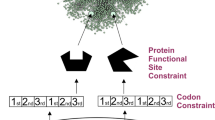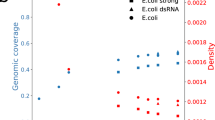Abstract
The relationship between the topology of a biological network and its functional or evolutionary properties has attracted much recent interest. It has been suggested that most, if not all, biological networks are ‘scale free.’ That is, their connections follow power-law distributions, such that there are very few nodes with very many connections and vice versa. The number of target genes of known transcriptional regulators in the yeast, Saccharomyces cerevisiae, appears to follow such a distribution, as do other networks, such as the yeast network of protein–protein interactions. These findings have inspired attempts to draw biological inferences from general properties associated with scale-free network topology. One often cited general property is that, when compromised, highly connected nodes will tend to have a larger effect on network function than sparsely connected nodes. For example, more highly connected proteins are more likely to be lethal when knocked out. However, the correlation between lethality and connectivity is relatively weak, and some highly connected proteins can be removed without noticeable phenotypic effect. Similarly, network topology only weakly predicts the response of gene expression to environmental perturbations. Evolutionary simulations of gene-regulatory networks, presented here, suggest that such weak or non-existent correlations are to be expected, and are likely not due to inadequacy of experimental data. We argue that ‘top-down’ inferences of biological properties based on simple measures of network topology are of limited utility, and we present simulation results suggesting that much more detailed information about a gene’s location in a regulatory network, as well as dynamic gene-expression data, are needed to make more meaningful functional and evolutionary predictions. Specifically, we find in our simulations that: (1) the relationship between a gene’s connectivity and its fitness effect upon knockout depends on its equilibrium expression level; (2) correlation between connectivity and genetic variation is virtually non-existent, yet upon independent evolution of networks with identical topologies, some nodes exhibit consistently low or high polymorphism; and (3) certain genes show low polymorphism yet high divergence among independent evolutionary runs. This latter pattern is generally taken as a signature of positive selection, but in our simulations its cause is often neutral coevolution of regulatory inputs to the same gene.
Similar content being viewed by others
References
Albert R, Jeong H, Barabási A-L (2000a) Error and attack tolerance of complex networks. Nature 406:378–382
Albert R, Jeong H, Barabási A-L (2000b) Error and attack tolerance of complex networks (Correction). Nature 409:542
Almaas E, Kovács B, Vicsek T, Oltvai ZN, Barabási A-L (2004) Global organization of metabolic fluxes in the bacterium Escherichia coli. Nature 427:839–843
Alon U (2003) Biological networks: the tinkerer as an engineer. Science 301:1866–1867
Arita M (2004) The metabolic world of Escherichia coli is not small. Proc Natl Acad Sci U S A 101:1543–1547
Barabási A-L, Albert R (1999) Emergence of scaling in random networks. Science 286:509–512
Barabási A-L, Oltvai ZN (2004) Network biology: understanding the cell’s functional organization. Nat Rev Genet 5:101–113
Batagelj V, Mrvar A (1998) Pajek—program for large network analysis. Connections 21:47–57
Bergman A, Siegal ML (2003) Evolutionary capacitance as a general feature of complex gene networks. Nature 424:549–552
Bray D (2003) Molecular networks: the top-down view. Science 301:1864–1865
Davidson EH (2001) Genomic regulatory systems: development and evolution. Academic Press, San Diego, CA
Davidson EH, Rast JP, Oliveri P, Ransick A, Calestani C, Yuh C-H, Minokawa T, Amore G, Hinman V, Arenas-Mena C, Otim O, Brown CT, Livi CB, Lee PY, Revilla R, Rust AG, Pan Zj, Schilstra MJ, Clarke PJC, Arnone MI, Rowen L, Cameron RA, McClay DR, Hood L, Bolouri H, (2002) A genomic regulatory network for development. Science 295:1669–1678
Erdös P, Rényi A (1960) On the evolution of random graphs. Publ Math Inst Hung Acad Sci 5:17–61
Featherstone DE, Broadie K (2002) Wrestling with pleiotropy: genomic and topological analysis of the yeast gene expression network. Bioessays 24:267–274
Frank SA (1999) Population and quantitative genetics of regulatory networks. J Theor Biol 197:281–294
Gasch AP, Spellman PT, Kao CM, Carmel-Harel O, Eisen MB, Storz G, Botstein D, Brown PO (2000) Genomic expression programs in the response of yeast cells to environmental changes. Mol Biol Cell 11:4241–4257
Gavin A-C, Bösche M, Krause R, Grandi P, Marzioch M, Bauer A, Schultz J, Rick JM, Michon A-M, Cruciat C-M, Remor M, Höfert C, Schelder M, Brajenovic M, Ruffner H, Merino A, Klein K, Hudak M, Dickson D, Rudi T, Gnau V, Bauch A, Bastuck S, Huhse B, Leutwein C, Heurtier M-A, Copley RR, Edelmann A, Querfurth E, Rybin V, Drewes G, Raida M, Bouwmeester T, Bork P, Seraphin B, Kuster B, Neubauer G, Superti-Furga G (2002) Functional organization of the yeast proteome by systematic analysis of protein complexes. Nature 415:141–147
Gertner J (2003) Social networks. The New York Times 12/14/03, section 6, p. 92
Giot L, Bader JS, Brouwer C, Chaudhuri A, Kuang B, Li Y, Hao YL, Ooi CE, Godwin B, Vitols E, Vijayadamodar G, Pochart P, Machineni H, Welsh M, Kong Y, Zerhusen B, Malcolm R, Varrone Z, Collis A, Minto M, Burgess S, McDaniel L, Stimpson E, Spriggs F, Williams J, Neurath K, Ioime N, Agee M, Voss E, Furtak K, Renzulli R, Aanensen N, Carrolla S, Bickelhaupt E, Lazovatsky Y, DaSilva A, Zhong J, Stanyon CA, Finley RL Jr, White KP, Braverman M, Jarvie T, Gold S, Leach M, Knight J, Shimkets RA, McKenna MP, Chant J, Rothberg JM (2003) A protein interaction map of Drosophila melanogaster. Science 302:1727–1736
Guelzim N, Bottani S, Bourgine P, Képès F (2002) Topological and causal structure of the yeast transcriptional regulatory network. Nat Genet 31:60–63
Guet CC, Elowitz MB, Hsing W, Leibler S (2002) Combinatorial synthesis of genetic networks. Science 296:1466–1470
Hahn MW, Conant GC, Wagner A (2004) Molecular evolution in large genetic networks: does connectivity equal constraint? J Mol Evol 58:203–211
Hahn MW, Kern AD (2005) Comparative genomics of centrality and essentiality in three eukaryotic protein-interaction networks. Mol Biol Evol 22:803–806
Hartl DL, Clark AG (1989) Principles of population genetics. Sinauer Associates, Inc., Sunderland, MA
Hartl DL, Taubes CH (1996) Compensatory nearly neutral mutations: selection without adaptation. J Theor Biol 182:303–309
Ho Y, Gruhler A, Heilbut A, Bader GD, Moore L, Adams S-L, Millar A, Taylor P, Bennett K, Boutilier K, Yang L, Wolting C, Donaldson I, Schandorff S, Shewnarane J, Vo M, Taggart J, Goudreault M, Muskat B, Alfarano C, Dewar D, Lin Z, Michalickova K, Willems AR, Sassi H, Nielsen PA, Rasmussen KJ, Andersen JR, Johansen LE, Hansen LH, Jespersen H, Podtelejnikov A, Nielsen E, Crawford J, Poulsen V, Sørensen BD, Matthiesen J, Hendrickson RC, Gleeson F, Pawson T, Moran MF, Durocher D, Mann M, Hogue CWV, Figeys D, Tyers M (2002) Systematic identification of protein complexes in Saccharomyces cerevisiae by mass spectrometry. Nature 415:180–183
Ideker T, Galitski T, Hood L (2001) A new approach to decoding life: systems biology. Annu Rev Genomics Hum Genet 2:343–372
Jeong H, Mason SP, Barabási A-L, Oltvai ZN (2001) Lethality and centrality in protein networks. Nature 411:41–42
Jeong H, Tombor B, Albert R, Oltvai ZN, Barabási A-L (2000) The large-scale organization of metabolic networks. Nature 407:651–654
Johnson NA, Porter AH (2000) Rapid speciation via parallel, directional selection on regulatory genetic pathways. J␣Theor Biol 205:527–542
Johnson NA, Porter AH (2005) Evolution of branched regulatory genetic pathways: directional selection on pleiotropic loci accelerates developmental system drift. Genetica, this issue
Kim PM, Tidor B (2003) Limitations of quantitative gene regulation models: a case study. Genome Res 13:2391–2395
Kitano H (2002) Systems biology: a brief overview. Science 295:1662–1664
Levesque MP, Benfey PN (2004) Systems biology. Curr Biol 14:R179–R180
Li S, Armstrong CM, Bertin N, Ge H, Milstein S, Boxem M, Vidalain P-O, J-Han DJ, Chesneau A, Hao T, Goldberg DS, Li N, Martinez M, Rual J-F, Lamesch P, Xu L, Tewari M, Wong SL, Zhang LV, Berriz GF, Jacotot L, Vaglio P, Reboul J, Hirozane-Kishikawa T, Li Q, Gabel HW, Elewa A, Baumgartner B, Rose DJ, Yu H, Bosak S, Sequerra R, Fraser A, Mango SE, Saxton WM, Strome S, van den Heuvel S, Piano F, Vandenhaute J, Sardet C, Gerstein M, Doucette-Stamm L, Gunsalus KC, Harper JW, Cusick ME, Roth FP, Hill DE, Vidal M (2004) A map of the interactome network of the metazoan C elegans. Science 303:540–543
Li W-H (1997) Molecular evolution. Sinauer Associates, Inc., Sunderland, MA
Mangan S, Alon U (2003) Structure and function of the feed-forward loop network motif. Proc Natl Acad Sci U S A 100:11980–11985
Phillips PC, Otto SP, Whitlock MC (2000) Beyond the average: the evolutionary importance of gene interactions and variability of epistatic effects, in Epistasis and the evolutionary process, edited by Wolf JB, Brodie ED, III, Wade MJ. Oxford University Press, New York, NY
Porter AH, Johnson NA (2002) Speciation despite gene flow when developmental pathways evolve. Evolution 56:2103–2111
Promislow D (2005) A regulatory network analysis of phenotypic plasticity in yeast. Am Nat 165:515–523
Proulx SR, Promislow DEL, Phillips PC (2005) Network thinking in ecology and evolution. Trends Ecol Evol 20:345–353
Pržulj N, Wigle DA, Jurisica I (2004) Functional topology in a network of protein interactions. Bioinformatics 20:340–348
Shen-Orr SS, Milo R, Mangan S, Alon U (2002) Network motifs in the transcriptional regulation network of Escherichia coli. Nat Genet 31:64–68
Siegal ML, Bergman A (2002) Waddington’s canalization revisited: Developmental stability and evolution. Proc Natl Acad Sci U S A 99:10528–10532
Sokal RR, Rohlf FJ (1995) Biometry. W. H. Freeman and Company, New York, NY
Stumpf MPH, Wiuf C, May RM (2005) Subnets of scale-free networks are not scale-free: sampling properties of networks. Proc Natl Acad Sci U S A 102:4221–4224
True JR, Haag ES (2001) Developmental system drift and flexibility in evolutionary trajectories. Evol. Dev. 3:109–119
von Mering C, Krause R, Snel B, Cornell M, Oliver SG, Fields S, Bork P (2002) Comparative assessment of large-scale data sets of protein–protein interactions. Nature 417:399–403
Wagner A (1996) Does evolutionary plasticity evolve? Evolution 50:1008–1023
Wagner A (2003) Does selection mold molecular networks? Sci. STKE 2003:341
Wagner A, Fell DA (2001) The small world inside large metabolic networks. Proc R Soc Lond B Biol Sci 268:1803–1810
Wuchty S, Oltvai ZN, Barabási A-L (2003) Evolutionary conservation of motif constituents in the yeast protein interaction network. Nat Genet 35:176–179
Yook S-H, Oltvai ZN, Barabási A-L (2004) Functional and topological characterization of protein interaction networks. Proteomics 4:928–942
Yu H, Luscombe NM, Qian J, Gerstein M (2003) Genomic analysis of gene expression relationships in transcriptional regulatory networks. Trends Genet 19:422–427
Zuckerkandl E (1997) Neutral and nonneutral mutations: the creative mix—evolution of complexity in gene interaction systems. J Mol Evol 44:S2–8
Acknowledgements
The authors thank Norman Johnson and Matthew Hahn for helpful comments on the manuscript. During part of this work, M.L.S. was supported by an NIH NRSA postdoctoral fellowship, and thanks Bruce Baker for his support. A.B. thanks Eric and Illeana Benhamou and The Benhamou Global Ventures, and The Rockefeller Foundation Creativity & Culture Program, for their generous and continual support. D.E.L.P.’s contribution to this work was supported by the National Science Foundation under Grant No. 0214022, and by the Ellison Medical Foundation.
Author information
Authors and Affiliations
Corresponding author
Rights and permissions
About this article
Cite this article
Siegal, M.L., Promislow, D.E.L. & Bergman, A. Functional and evolutionary inference in gene networks: does topology matter?. Genetica 129, 83–103 (2007). https://doi.org/10.1007/s10709-006-0035-0
Received:
Accepted:
Published:
Issue Date:
DOI: https://doi.org/10.1007/s10709-006-0035-0




